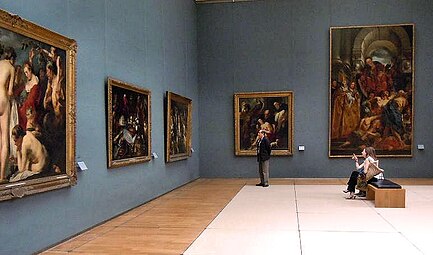
Royal Museums of Fine Arts of Belgium
The Royal Museums of Fine Arts of Belgium (French: Musées royaux des Beaux-Arts de Belgique; Dutch: Koninklijke Musea voor Schone Kunsten van België) are a group of art museums in Brussels, Belgium. They include six museums: the Oldmasters Museum, the Magritte Museum, the Fin-de-Siècle Museum, the Modern Museum, the Antoine Wiertz Museum and the Constantin Meunier Museum.
Established
The Royal Museums contains over 20,000 drawings, sculptures, and paintings, covering a period extending from the early 15th century to the present, such as those of Flemish old masters like Bruegel, Rogier van der Weyden, Robert Campin, Anthony van Dyck, Jacob Jordaens, and Peter Paul Rubens, making it the most popular art institution and most visited museum complex in Belgium. The Magritte Museum houses the world's largest collection of the works of the surrealist René Magritte.
History[edit]
Early history[edit]
The museum was founded in 1801 by Napoleon[1] and opened in 1803 as the Museum of Fine Arts of Brussels (French: Musée des Beaux-Arts de Bruxelles, Dutch: Museum voor Schone Kunsten van Brussel), occupying fourteen rooms of the former Palace of Charles of Lorraine, known as the "Old Court". The first collection, the core of the current collections of Ancient Art, consisted of a selection of "old deposits", works of art seized by the French Republic but abandoned (1798), increased by two shipments from Paris (1802 and 1811), and returned works taken away by the Republic (1815).[2] Later, during the Dutch period, King William I of the Netherlands sponsored an expansion of the collection (1817 and 1819) and had two wings built on the current Place du Musée/Museumplein (the so-called Palace of National Industry, opened in 1830).
Following Belgian independence, the museum, which had belonged to the City of Brussels since 1811, was ceded to the Belgian State in 1841. The transfer of the Contemporary Art collection from the Ministry of the Interior in 1834 is at the origin of the Modern Art section. In 1845, it was decided, by royal decree,[3] that the museum was to receive works of art of deceased and living Belgian artists. A national commission was established to select important works of art. The first president of the commission was the Count de Beaufort. Other members were Gustaf Wappers, François-Joseph Navez, Guillaume Geefs, Eugène Simonis, Tilman-François Suys and Luigi Calamatta. Many of these founding members were active in the Royal Academy of Science, Letters and Fine Arts of Belgium.
Until 1878, the Brussels Salon, a periodic exhibition of work by living artists, took place in the former apartments of Charles Alexander of Lorraine. This situation was not ideal because the permanent collection had to be temporarily stored or covered during the exhibition. In addition, the exhibitors complained that all paintings were not lit equally well. Renovation works were carried out so that in 1830 a Great Gallery could open with a skylight. Nevertheless, low-hanging works were still difficult to see. In 1851, the exhibition was held in a temporary construction in the courtyard, before returning to its traditional location until 1881, when the first rooms of the new Museum of Fine Arts could be used. This museum remained the location for all subsequent editions.
The works of the Old Masters were finally moved from the Palace of Charles of Lorraine to the Rue de la Régence/Regentschapsstraat in 1887, giving a new purpose to Alphonse Balat's Palace of Fine Arts (French: Palais des Beaux-Arts, Dutch: Paleis voor Schone Kunsten), which had opened in 1880 (not to be confused with the current Centre for Fine Arts).
The chief curators or directors of the museum have been:
Visitors[edit]
For many years now, the Royal Museums of Fine Arts of Belgium has been the most popular art institution in Belgium. The museums had a total of approximately 715,000 visitors in 2010.[12] This puts the museum in the top 100 most visited museums in the world and makes it the most visited museum complex in Belgium. Thanks to the opening of the Magritte Museum, the number of unique visitors has remarkably increased since 2009. In 2015, the Museum had its best attended year so far with a total of 767,355 visitors.[13] The Magritte Museum received about 425,000 visitors in 2010, making it the most successful part of the museums.[14]
This strategy was accompanied by a significant increase in corporate funding. From 2005 until 2017, the number of visitors has doubled and the turnover tripled, thereby reducing the State contribution from 54.4% of the global budget to 32%. This was achieved during a period of very severe budgetary cuts: 11% in 2013 and 2014, 30% for the period 2015–2019.[15]


